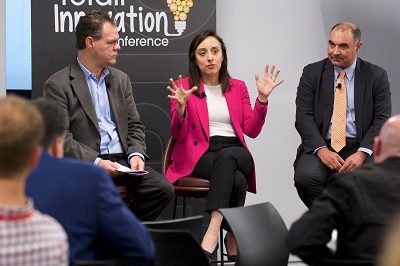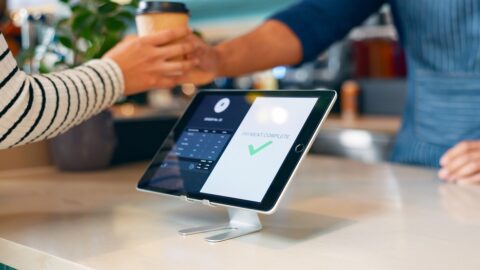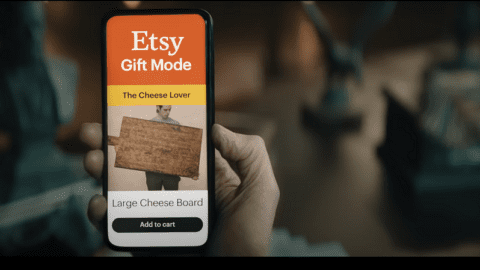(l. to r.) Andrew Gaffney, Retail TouchPoints; Katharine Bahamonde Monasebian, Barneys New York; Todd Treonze, Brooks Brothers
The 24 small-group breakout sessions at the 2019 Retail Innovation Conference were organized into four tracks. Coverage of the Digital Strategies and Operational Planning sessions were published on May 31; following are recaps of key presentations from the Marketing/Customer Engagement and Omnichannel CX tracks.
MARKETING/CUSTOMER ENGAGEMENT
Strategies For Strengthening Businesses By Empowering Women Leaders
Advertisement
Women who are waiting for businesses and organizations to make top-level changes toward becoming more inclusive and female-friendly can’t “wait for a path to be built for you,” said Monika Tockstein, Senior Manager, PMO & QA at Retailwinds. “You must start making the change, and bring fellow women along with you,” she added. “And if you don’t see a woman mentor at the next level, some of your best mentors might be men, inside or outside the organization. Be the change while we’re waiting for the top to catch up.” Glamsquad CEO Amy Shecter noted that when she joined the beauty service three years ago, the first engineering and product meetings she attended were all-male. Shecter quickly realized that “we need women in these rooms” so that everyone understands the impact hair and beauty products can have on a customer’s life: “How am I going to explain that if you have a bad blowout it ruins your day to a sea of men who, in general, have little or no hair?” she said, adding “our goal is to have a company with 50% women.”
When The Digital Shelf Informs The Physical Shelf
Content and search are vitally important to successful e-Commerce strategies, and retailers need to consider how other digital tools can improve results at brick-and-mortar stores, according to Tony Southard, Senior Director, E-Commerce Sales at The Hershey Company. Utilizing smart lists and shoppers’ previous purchasing history can drive repeat sales, taking what may initially have been an unplanned purchase and making it a regular part of the shopping list on future trips. Driving repeat purchases is particularly important in confectionary, a category where 44% of purchases are unplanned.
CIO Insights: Assessing The Top Retail Tech Priorities
Todd Treonze, CIO of Brooks Brothers, and Katherine Bahamonde Monasebian, Chief Digital and Technology Officer and EVP, Barneys New York, chatted with Retail TouchPoints Editorial Director Andrew Gaffney about how the retailers are shifting away from a channel-based focus to a more fluid view of digital retail. Monasebian noted that while retail remains a key focus for Barneys, the company is becoming a brand platform that is in the entertainment, event and even restaurant businesses. For its part, Brooks Brothers has begun to leverage its online data to help associates improve their store performance. “One of the tools we showed in the Store Tour was our concierge application, which is an associate-facing app that collects a lot of great information we have from our CRM and loyalty system and integrates it with the POS,” said Treonze. “It allows us to do two-way interactions directly with the client via text or email.” When it comes to this kind of physical-digital convergence, there’s an increasing realization that technology will need to be completely interconnected into the new retail experience, “but the challenge is cutting through the noise,” Monasebian said.
Rethinking Influencer Marketing – Tools And Strategies Redefining The Brand-Influencer Relationship
One key to successful influencer marketing is to pitch entire programs, not specific people, according to Monica Fineis, Director of Social & Digital Media at Brooks Brothers. Even the biggest influencers don’t have the same reach as a large, diverse cast of individuals who can each promote a brand to a different audience. Retailers also need to give their influencers a degree of freedom, according to Mary Orton, CEO at Trove. Influencers are more likely to work with retailers that have done their research, and that have chosen a partner who already aligns with their message.
The Experiential Era: How Brands Are Using Events To Drive Conversions And Build Loyal Communities
Retailers seeking to use events to reach community-building and bottom-line goals must first understand who their shoppers are. Brands with extensive customer data have a head start: for example, Hemang Mehta, Co-Founder of Squip, said, “We are kind of spoiled, because when you have a game with 250 million hours watched, you know where the customer is.” Mehta revealed that gamers don’t fit the stereotype of the socially challenged young male: “The typical age of a gamer is 35 years old, and 40% are female, so our challenge is how we create a custom experience that goes from the virtual [world] to the real world.” Retailers also can use a multi-tier approach to events to meet multiple goals: “Events are central to Sleep Number’s success, both at the national level, such as those associated with the Super Bowl, and at the store level,” said Angela Gearhart, VP of Brand Experience at Sleep Number. “Each event has a specific objective to deliver on; the NFL partnership and our events at the CES show are about driving awareness, while local events are about appointment setting.”
OMNICHANNEL CX
How Lucky Brand Optimizes Allocation And Fulfillment With Advanced Analytics
As Lucky Brand made an aggressive push to grow its distribution network, the company recognized the limitations of its historic allocation and fulfillment processes. Miles Barger, VP of Merchandise Planning, Allocation and Inventory Optimization at Lucky Brand, revealed that by rethinking its inventory allocation approach to “shuffling the deck,” the retailer could better decide which products were sold online and which ones were better rebalanced across the chain. Additionally, with the Celect platform, the retailer managed to:
• Eliminate 407 of 757 worst-performing products;
• Reduce investments in 220 of 757 underperforming products; and
• Save $5.8 million and increase its turn rate.
“If you’re used to a regular allocation model, you’re usually allocating style-by-style,” said Barger. For example, “at one of our highest-volume stores in the Time Warner Center, if we’re planning [to allocate] woven shirts, no matter what kind of woven shirt it is, that store is getting 4X the average of a regular store. What is life-changing about the new model is that instead of this store getting 4X the average of each color of the woven shirt, it will get 5X the average in one color if it is selling well, and 2X of those that are not selling well.”
One (Shoe) Size Doesn’t Fit All: Implementing Personalization
The personalization bar has been raised by companies like Netflix, so traditional segmentation is no longer enough for a retail message to stand out, according to Frank Malsbenden, VP/General Manager, E-Commerce at Berkshire Hathaway Shoe Holdings. Strong campaigns need a “wow” factor that makes customers pay attention, and reaching the necessary level of personalization requires modern tools. Retailers need to harness machine learning and AI to truly approach shoppers as individuals, not faceless members of a larger group, in order to deliver recommendations and promotions that make them feel appreciated.
The Sound Of Success: How GasBuddy And Audible’s Partnership Fueled Growth
On average, 5% of U.S. household expenditures go to purchase gasoline, but it’s a “grudge purchase” — one that’s necessary but generally made unwillingly — according to Mark Coffey, EVP of Strategic Partnerships at GasBuddy. “It represents a pain point, so our partnerships are designed to save you money on the things you need, so that you can spend on the things you like.” The substitution of pain for pleasure is one reason behind the success of GasBuddy’s partnership with Audible, which has so far awarded more than $100,000 in GasBack credits to GasBuddy users that sign up for the service. Another reason the partnership works is that “context matters — audiobooks are consumed in cars, so there is nothing confusing for the customer,” said Coffey. From Audible’s standpoint, the company likes to work “with brands that scale, and GasBuddy has a large number of users and wants to monetize them,” said Nitin Kartik, Director of Strategic Partnerships at Audible. However, he warned that “a big audience doesn’t necessarily mean an engaged audience. Scale plus engagement is the recipe for success.”
Bringing Innovation To Life To Create A 360⁰ Experience With People For People
Data powers innovation, but it should be used to fuel the process rather than validate existing views, according to Ruth Crowley, former Head of Customer Experience Design at Lowe’s. There’s a major disconnect between retailers’ intentions and the actual impact of their actions: Even though 80% of CEOs say they’re working on initiatives that will improve the customer experience, only 8% of customers agree. Retailers must start by defining the customer experience, and focus on creating shopping journeys that adhere to what customers expect, not what executives think they want.
Cultivating Talent That Supports A Culture Of Innovation
Urban Outfitters and ADAY come from two completely different eras of retailing, but both take similar approaches when it comes to bringing top talent into their businesses. Nina Faulhaber, Co-Founder and CEO, ADAY, explained that as an entrepreneur herself, she is looking for an entrepreneurial spirit in new hires, regardless of whether it’s for a traditional or newer role. “What projects have you led and initiated?” is a major question Faulhaber often poses. Matthew Strode, Chief Talent Officer at Urban Outfitters, emphasized the need for testing, especially when it comes to engineering and design positions, which now drive the digital side of the business. The differences between the companies appear through their pain points: Strode acknowledged that at times there is a level of “buy-in” he needs from the leadership team to get support for the way the retailer hires: “teaching them to assess the talent can sometimes be the hardest part.” While the ADAY team doesn’t have this buy-in issue, the fashion retailer is in a unique situation — in a company of two dozen employees, it recently just hired its first male. Depending on the job posting, there are typically 200 female applicants per one male applicant, which Faulhaber said makes it harder to establish diversity across not only gender, but age and demographics.









